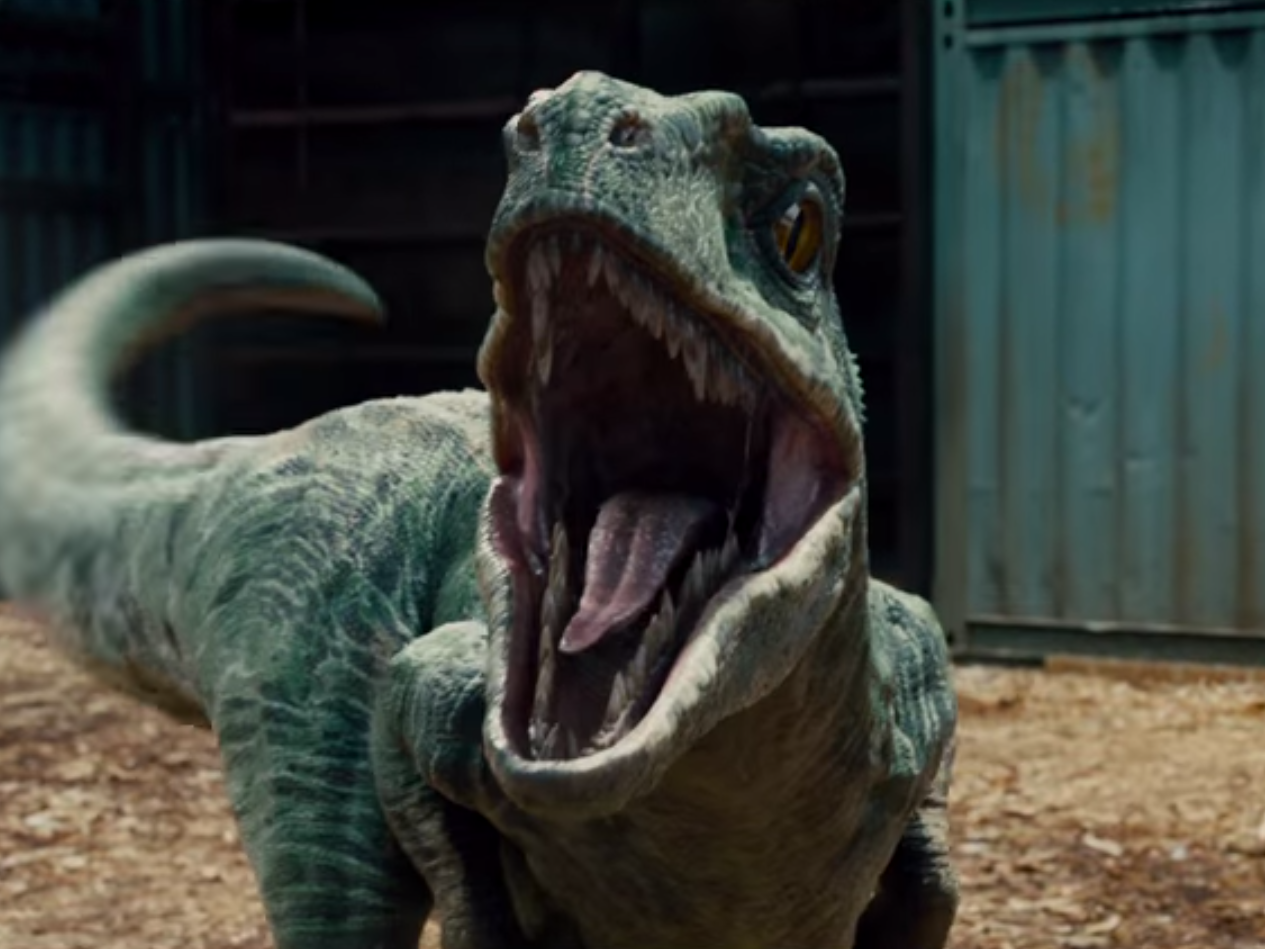- In an iconic scene in the Hollywood blockbuster “Jurassic Park,” velociraptors hunt down two children in a kitchen.
- One raptor fogs up the glass on the kitchen door as it eyes its prey – a sign that these dinosaurs were warm-blooded, not cold-blooded.
- According to the film’s science adviser, the raptors in that scene almost had forked tongues. He cautioned director Steven Spielberg against it.
- A forked tongue would have been scientifically inaccurate, since these dinosaurs were more like birds than snakes.
- Visit Business Insider’s homepage for more stories.
In one of the scariest scenes in Steven Spielberg’s Hollywood blockbuster “Jurassic Park,” two velociraptors stalk two children in a cafeteria kitchen.
The kids, Lex and Tim, peek nervously around a corner to see if their carnivorous pursuers have found them, and the camera pans to show a raptor peering through a window in the kitchen door. Its heavy breath fogs up the glass.
According to the movie’s science adviser, Jack Horner, the raptors in that iconic scene almost looked very different.
Horner, a paleontologist from Montana State University, has served as an adviser for all five movies in Universal’s “Jurassic Park” and “Jurassic World” franchises. He told Business Insider that he had to convince Spielberg to not give the velociraptors a snake-like aesthetic.
"Originally Steven wanted them to walk in flicking their forked tongues," Horner said. "I said, 'No, no you cannot do that.'"
Giving the raptors a forked tongue would have been scientifically inaccurate, since these dinosaurs were more closely related to birds than snakes.
Dinosaurs probably didn't have forked tongues

Spielberg isn't wholly to blame for wanting to give his raptors an unscientific tongue: In the "Jurassic Park" book upon which the movie is based, author Michael Crichton describes a Tyrannosaurus rex as having a forked tongue.
In the novel, a T. rex chases Lex and Tim behind a waterfall. (For movie viewers, this is similar to a scene in the 1997 sequel "The Lost World.")
Crichton writes of the T. rex: "With a low growl, the jaws slowly opened, and the tongue snaked out. It was thick and blue-black, with a little forked indentation at the tip. It was 4 feet long, and easily reached back to the far wall of the recess."
But realistically, it's unlikely that the T. rex or velociraptor - or any dinosaur, for that matter - had a forked tongue the way modern-day snakes do.
Read More: The velociraptors in the 'Jurassic Park' movies are nothing like their real-life counterparts

Forked tongues help some reptiles discern which direction a smell is coming from. But paleontologists have shown that dinosaurs were the ancestors of today's birds, which don't have forked tongues. Plus, they were more closely related to crocodiles and alligators (which also do not sport forked tongues) than snakes.
A warm-blooded win
Horner said he and Spielberg never fought about paleontology; rather, Horner said, Spielberg was "always asking what I thought of this that, I'd interject things, and he would choose to heed my advice or not."
Nonetheless, the kitchen scene represents a scientific victory for Horner.
Instead of flicking out a forked tongue, the raptor breathes on the cold surface of the kitchen window, causing condensation.
That's a clear indication that the dinosaurs depicted in "Jurassic Park" were warm-blooded, since it shows the raptor's internal temperature was warmer than its environment. At the time the movie came out, debate still raged among paleontologists about whether these creatures were warm- or cold-blooded.
But Horner was sure that dinosaurs didn't depend on their external environment to modulate their internal body temperatures, and were less slow and sluggish (characteristics associated with cold-bloodedness) than the way previous portrayals had depicted them. As it turns out, he was mostly right.
Although paleontologists still don't agree about exactly where dinosaurs fall on the cold- to warm-blooded spectrum, a 2014 study found that these creatures most likely fell somewhere in the middle, unable to fully regulate their internal temperatures but "also not entirely at the whim of the environment."
Dinosaurs were "neither slow goliaths nor supercharged reptiles," the authors wrote.
Scientists who agree with Horner's stance took notice of the kitchen scene's scientific wink.
"The dinosaurs in Jurassic Park were explicitly warm-blooded," paleontologist Scott Persons told Business Insider. "That was critical because at the time, that was controversial."
That depiction, Persons said, ensured that the movie was on the cutting edge of paleontology, which was "key to the success of the film."
But the velociraptors in "Jurassic Park" still aren't as scientifically accurate as they could be. For one thing, Horner said, they should have feathers.

What's more, they're too big - velociraptors would have been the size of small turkeys.
More likely, paleontologists say, the creatures in the "Jurassic Park" kitchen scene are actually a different type of dinosaur called Deinonychus.

